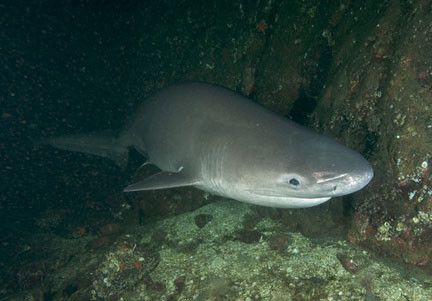
| |
| Scientific Name | Hexanchus griseus |
|---|---|
| Conservation Status | Near Threratened |
| Family | Chordata |
| Habitat | Temperate Ocean Rims |
| Food | Crustaceans, Mollusks, fish |
The bluntnose sixgill shark, Hexanchus griseus, often simply called the cow shark, is the largest hexanchoid shark, growing to more than 5.4 m (18 ft) in length.
This species typically inhabits depths greater than 90 m (300 ft), and has been recorded as deep as 1,875 m (6,150 ft). Like many deep-sea creatures, the bluntnose sixgill shark is known to undertake nightly vertical migrations (travelling surfaceward at night, returning to the depths before dawn).
The bluntnose sixgill shark can be seen at depths of 30 m (100 ft) and shallower during parts of the year in some specific places e.g. Flora Islet, near Hornby Island, Sightings during shallow evening dives in Whytecliff Park West Vancouver in British Columbia, in Puget Sound, Monterey Canyon off Monterey, California and in fjords in Norway. The sharks are deepsea sharks, but like most fish that prefer the deep, they come to the shallower depths to feed.
Although sluggish in nature, the bluntnose sixgill shark is capable of attaining high speeds for chasing and catching its prey. Because of the bluntnose sixgill shark's large and diverse range they have a wide variety of prey items. Their diet consists of a variety of mollusks, crustaceans, Agnathans (which is a family consisting of hagfish), and sea lampreys. They also dine on Cape anchovies, Pacific salmon, various species of hake. There are also many more species that are eaten depending upon the shark's home range. Despite its size, the shark is not known to have eaten any humans.